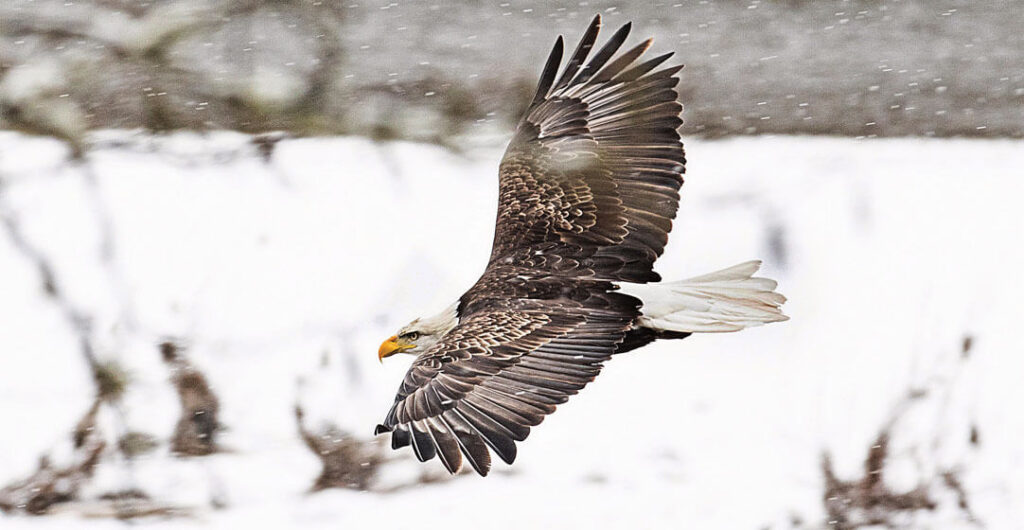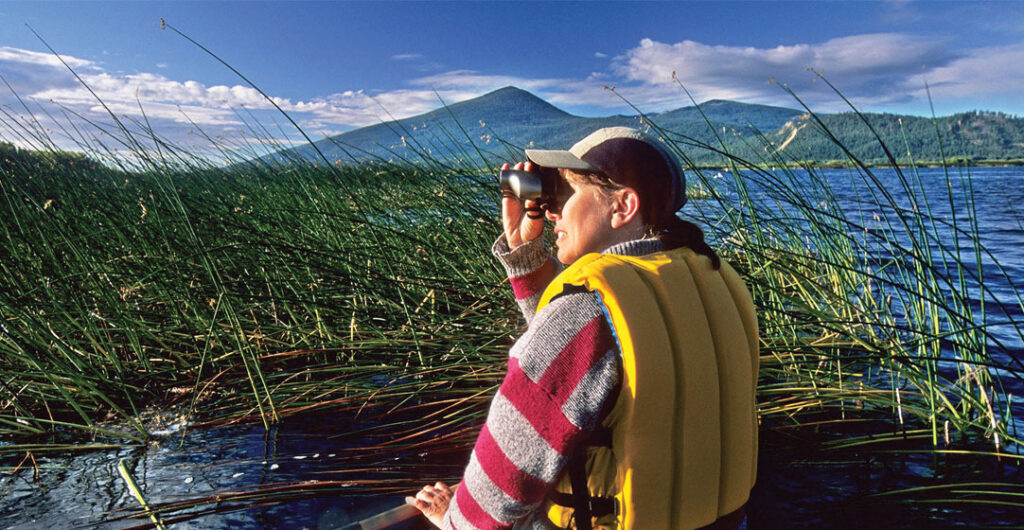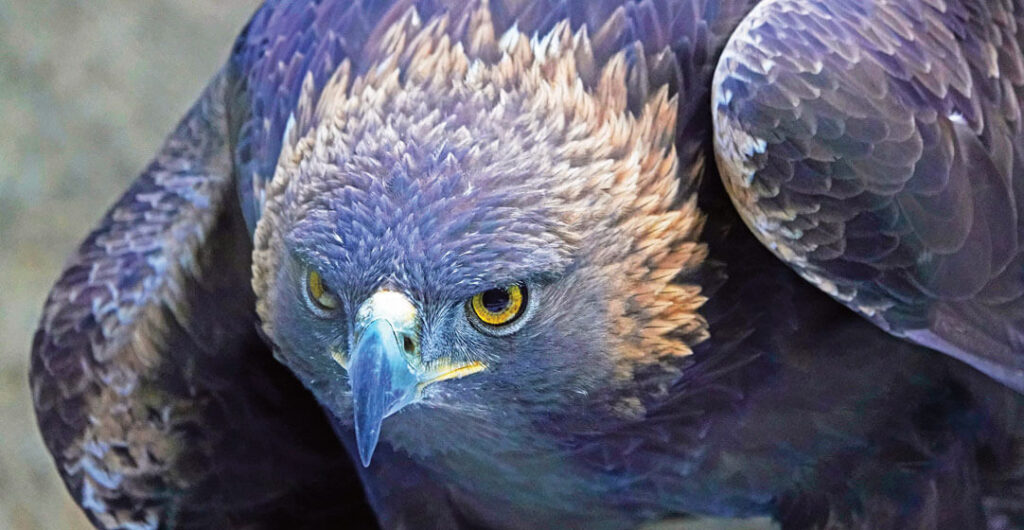Find the Best Places to See Bald and Golden Eagles
With their piercing eyes, curved talons and wingspans that can reach 6 feet, eagles have earned their place as revered residents of the Pacific Northwest. For centuries, people have viewed eagles as a symbol of bravery, honor and grace. And that is because the birds have many qualities humans have come to respect. They use their powerful vision to soar high and hunt their prey. They are monogamous creatures that nurture their young, and they are fierce defenders of their home, sometimes fighting in mid-air to death.
“They’re impressive,” says Jim Watson, a wildlife research scientist for the Washington Department of Fish and Wildlife who specializes in raptors. “They eat other things, which always makes for an exciting story. They don’t ignore each other; they interact with each other. They do cartwheels by engaging talons and twirling around in a circle and falling in the air.”
The Pacific Northwest is home to two types of eagles: the bald eagle and the golden eagle. And winter is the best time to see them, because eagles feed on prey such as salmon or animal carcasses, which are more plentiful in the winter. Both types of eagles have their own unique allure, which makes spotting either one a special moment during an outdoor adventure.

Bald Eagles
With their eye-catching white heads contrasting with their brown bodies, bald eagles are unmistakable. Earning the title of national bird just six years after the United States became a nation, the bald eagle is emblematic of our country. Although bald eagles exist all over the United States, those that call the Pacific Northwest home are among the largest. Unlike the rest of the year when they’re fairly spread out, winter is when bald eagles gather in large groups in places where there are salmon concentrations — waterways such as rivers and lakes.
Here are some places around the Northwest that offer the best chances to spot a bald eagle:
Harrison River Delta
At the confluence of the Fraser and Harrison rivers near Abbotsford, British Columbia, sits the Harrison River Delta and nearby Chehalis flats where every year, hundreds if not thousands of bald eagles flock to gorge on salmon. The gathering is considered the largest overwintering population of bald eagles. That is because the waters support North America’s largest populations of several salmon species. The Fraser Valley Bald Eagle Festival, which began in 1995 and was discontinued in 2020, alerted thousands of bird enthusiasts to the event. Subsequently, it also spurred the creation of the Chehalis Flats Bald Eagle & Salmon Preserve to help reduce the human disturbance to the area.
Upper Skagit River
Dotting the tree branches near Rockport along the banks of the Skagit River, a 150-mile waterway that carves the North Cascades, bald eagles can be seen in the hundreds during wintertime. Luckily for birders, Highway 20 follows the river. There are several places to stop and pull out your binoculars between Sedro-Woolley and Marblemount. This includes the Skagit River Bald Eagle Interpretive Center, which offers guided hikes and a speaker series each December and January.
Columbia River Gorge
Although there are a few spots along the Columbia River Gorge where bald eagles are known to congregate in the winter, The Dalles Dam is one spot to which these majestic birds reliably return year after year. A few weekends every winter, park rangers with the U.S. Forest Service and raptor handlers from the Columbia Gorge Discovery Center & Museum host an Eagle Watch event where they answer questions and host activities.

Klamath Basin
Spanning parts of southern Oregon and northern California, the Klamath Basin becomes home to hundreds of bald eagles each winter. The annual migration, which occurs between November and March, draws birders from across the region. The six wildlife refuges that make up the Klamath Basin National Wildlife Refuges are considered reliable places to see bald eagles in the winter.
Lake Coeur d’Alene
Sitting in the north panhandle of Idaho, Lake Coeur d’Alene and the surrounding area is noteworthy for regularly hosting bald eagles that visit the lake’s edge each winter to feed on kokanee salmon. Staff at the Bureau of Land Management sporadically tally the number of adult and juvenile eagles they see and report the number to the Lake Coeur d’Alene Eagle Watch webpage. Some suggested viewing areas include Higgens Point, Mineral Ridge Boat Ramp and Mineral Ridge National Recreation Trail, all located on the lake’s easternmost side.

Golden Eagles
With feathers that create a beautiful tapestry of brown, gold and white, golden eagles are a magnificent bird to witness. And that’s because aside from its beauty, finding one can be a difficult venture. Golden eagles are solitary creatures, don’t migrate in the winter and live in wide, open countryside with a home range that extends 6 miles from the nest.
That, along with their camouflage-like coloring, make spotting them a rare occurrence — but that just makes those moments more special. Note that immature bald eagles are also brown and are often confused with golden eagles. Some distinguishing characteristics between the two are that golden eagles have smaller heads and are feathered to the foot while bald eagles have larger heads and have unfeathered yellow ankles.
Here are some places around the region that offer a good chance for seeing a golden eagle:
Glacier Peak area
There have been a high number of reported sightings of golden eagles near Glacier Peak in Washington, home to roughly a dozen glaciers and remote hiking trails. The 29-mile White Pass-Pilot Ridge Loop, which connects to the Pacific Crest Trail, is one of the places within the Glacier Peak Wilderness Area where golden eagles have been spotted.
Yakima Canyon area
Golden eagles have been reliably seen near the city of Yakima, including along the Yakima River to the north and along the ridgelines and foothills to the east and west of the town. You may also spot a golden eagle along U.S. Highway 12 toward Naches, as well as in the Oak Creek Wildlife Area just outside of Naches.
Entiat River Valley
North of Wenatchee, the Entiat River Valley is a place where there have been known sightings of golden eagles. Also, nearby Jameson Lake and #2 Canyon just outside of Wenatchee are other places in the region where sightings have been recorded.
Blue Mountain region
In the southeast corner of Washington state, there are three wildlife areas where you can spot golden eagles: Chief Joseph, Aston Creek and W.T. Wooten wildlife areas. Each are home to a few trails where you can spot golden eagles. There are several spots along the Snake River extending south into Oregon where sightings have been reported.
Tips for eagle viewing
Bring your binoculars.
When you spot an eagle, remain stationary and don’t approach the bird.
Eagles are tolerant of humans as long as they don’t approach them, which reduces their feeding opportunity.
Your car is your best blind.
—Written by Emily Gillespie
—Top photo by RonPaulk Photography/AdobeStock
—This article appears in the Winter 2023 edition of AAA Washington member magazine, Journey.









